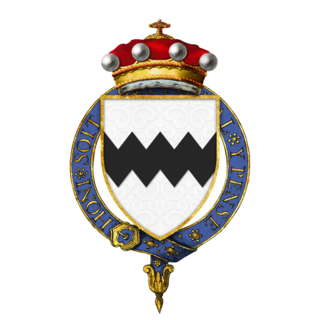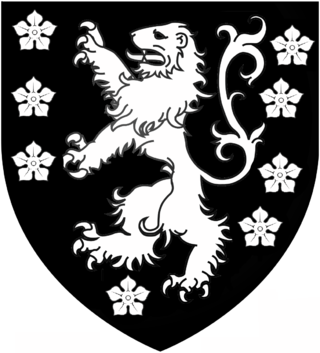Related Research Articles

William Hastings, 1st Baron Hastings KG was an English nobleman. A loyal follower of the House of York during the Wars of the Roses, he became a close friend and one of the most important courtiers of King Edward IV, whom he served as Lord Chamberlain. At the time of Edward's death he was one of the most powerful and richest men in England. He was executed following accusations of treason by Edward's brother and ultimate successor, Richard III. The date of his death is disputed; early histories give 13 June, which is the traditional date.

Ralph Neville, 1st Earl of WestmorlandEarl Marshal, was an English nobleman of the House of Neville.

Henry Stafford, 1st Earl of Wiltshire was an English peer.

Thomas West, 8th Baron De La Warr and 5th Baron West, KB, KG was an English courtier and military commander during the reigns of Henry VII and Henry VIII.

John Neville, 3rd Baron Neville, was an English peer, naval commander, and soldier. His second wife was Elizabeth Latimer who was the 5th Baroness Latimer in her own right.

Lionel de Welles, 6th Baron Welles, KG was an English peer who served as Lord Lieutenant of Ireland and Joint Deputy of Calais. He was slain fighting on the Lancastrian side at the Battle of Towton, and was attainted on 21 December 1461. As a result of the attainder, his son, Richard Welles, 7th Baron Welles, did not succeed him in the barony of Welles until the attainder was reversed by Parliament in June 1467.

Robert Willoughby, 6th Baron Willoughby de Eresby was an English nobleman and military commander in the Hundred Years' War.
Joan Willoughby,de jure suo jure7th Baroness Willoughby de Eresby was an English baroness in her own right.
Robert Welles, 8th Baron Willoughby de Eresby and 8th Baron Welles, was the son of Richard Welles, 7th Baron Welles, and Joan Willoughby, 7th Baroness Willoughby de Eresby. He was the prime mover in an uprising against Edward IV in 1470, although his actions were possibly orchestrated by Richard Neville, 16th Earl of Warwick.
Joan Welles,de jure suo jure9th Baroness Willoughby de Eresby, inherited the baronies of Welles and Willoughby at the death of her brother, Robert Welles, 8th Baron Willoughby de Eresby, in 1470.

Margaret Stafford was the daughter of Hugh de Stafford, 2nd Earl of Stafford, and Philippa de Beauchamp. She was the first wife of Ralph Neville, 1st Earl of Westmorland, and the grandmother of the 2nd Earl.

William Willoughby, 1st Baron Willoughby of Parham was an English nobleman and soldier who in 1547 was made an hereditary peer of the House of Lords.

Sir Gervase Clifton of Clifton, Nottinghamshire and London was a 15th-century English knight and landowner. He was beheaded after the Battle of Tewkesbury.

John Montagu, 3rd Earl of Salisbury and 5th and 2nd Baron Montagu, KG was an English nobleman, one of the few who remained loyal to Richard II after Henry IV became king.
Richard Welles, 7th Baron Welles (c.1428–1470), was an English nobleman and soldier. From a Lancastrian family, he came to be on good terms with the Yorkist King Edward IV, but was later executed after being associated with a plot against Edward known as the "Welles Uprising".
Mary Hungerford, Baroness Botreaux, Hungerford and Moleyns was the daughter of Sir Thomas Hungerford and Anne, daughter of Henry Percy, 3rd Earl of Northumberland.

William Willoughby, 5th Baron Willoughby de Eresby KG was an English baron.

Richard Neville, 2nd Baron Latimer KB of Snape, North Yorkshire, was an English soldier and peer. He fought at the battles of Stoke and Flodden.
Sir Richard Hastings, Baron Welles, was the son of Sir Leonard Hastings and a younger brother of William Hastings, 1st Baron Hastings. He was a favourite of Edward IV, who granted him the lands of the baronies of Willoughby and Welles after he had married the heiress, Joan Welles. He fought at Tewkesbury. He died in 1503, and was buried at the Greyfriars, London.
Sir Ralph Hastings, third son of Sir Leonard Hastings, was a supporter of the House of York during the Wars of the Roses. He fought at the Battle of Barnet, and was knighted at the Battle of Tewkesbury. He held numerous offices during the reign of Edward IV, including Keeper of the Lions and Leopards in the Tower of London, and Lieutenant of Guisnes and Captain of Calais.
References
- Bindoff, S.T. (1982). The House of Commons 1509-1558. Vol. III. London: Secker & Warburg. pp. 630–1.
- Burke, John (1831). A General and Heraldic Dictionary of the Peerages of England, Ireland and Scotland, Extinct, Dormant and in Abeyance. London: Henry Colburn. p. 562 . Retrieved 6 October 2013.
- Cokayne, George Edward (1926). Gibbs, Vicary (ed.). The Complete Peerage, edited by Vicary Gibbs. Vol. VI. London: St. Catherine Press.
- Cokayne, George Edward (1959). White, Geoffrey H. (ed.). The Complete Peerage, edited by Geoffrey H. White. Vol. XII, Part II. London: St. Catherine Press.
- Goff, Cecilie (1930). A Woman of the Tudor Age. London: John Murray.
- Hicks, Michael (2004). "Willoughby family". Oxford Dictionary of National Biography (online ed.). Oxford University Press. doi:10.1093/ref:odnb/52801.(Subscription or UK public library membership required.)
- Jones, Michael K.; Underwood, Malcolm G. (1992). The King's Mother: Lady Margaret Beaufort, Countess of Richmond and Derby. Cambridge: Cambridge University Press. ISBN 9780521447942.
- Richardson, Douglas (2011). Everingham, Kimball G. (ed.). Magna Carta Ancestry: A Study in Colonial and Medieval Families. Vol. I (2nd ed.). Salt Lake City. ISBN 978-1-4499-6637-9.
{{cite book}}: CS1 maint: location missing publisher (link) - Richardson, Douglas (2011). Everingham, Kimball G. (ed.). Magna Carta Ancestry: A Study in Colonial and Medieval Families. Vol. II (2nd ed.). Salt Lake City. ISBN 978-1449966393.
{{cite book}}: CS1 maint: location missing publisher (link) - Richardson, Douglas (2011). Everingham, Kimball G. (ed.). Magna Carta Ancestry: A Study in Colonial and Medieval Families. Vol. III (2nd ed.). Salt Lake City. ISBN 978-1449966386.
{{cite book}}: CS1 maint: location missing publisher (link) - Richardson, Douglas (2011). Everingham, Kimball G. (ed.). Magna Carta Ancestry: A Study in Colonial and Medieval Families. Vol. IV (2nd ed.). Salt Lake City. ISBN 978-1460992708.
{{cite book}}: CS1 maint: location missing publisher (link)